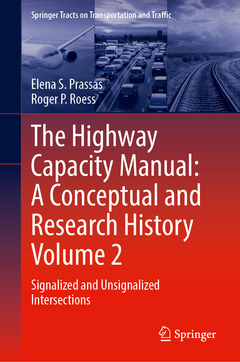Description
The Highway Capacity Manual: A Conceptual and Research History Volume 2, 1st ed. 2020
Signalized and Unsignalized Intersections
Springer Tracts on Transportation and Traffic Series, Vol. 12
Authors: Prassas Elena S., P. Roess Roger
Language: English
Subjects for The Highway Capacity Manual: A Conceptual and Research...:
168.79 €
In Print (Delivery period: 15 days).
Add to cart
Publication date: 01-2020
395 p. · 15.5x23.5 cm · Hardback
395 p. · 15.5x23.5 cm · Hardback
Description
/li>Contents
/li>Comment
/li>
Since 1950, the Highway Capacity Manual has been a standard used in the planning, design, analysis, and operation of virtually any highway traffic facility in the United States. It has also been widely used around the globe and has inspired the development of similar manuals in other countries.
This book is Volume II of a series on the conceptual and research origins of the methodologies found in the Highway Capacity Manual. It focuses on the most complex points in a traffic system: signalized and unsignalized intersections, and the concepts and methodologies developed over the years to model their operations. It also includes an overview of the fundamental concepts of capacity and level of service, particularly as applied to intersections.
The historical roots of the manual and its contents are important to understanding current methodologies, and improving them in the future. As such, this book is a valuable resource for current and future users of the Highway Capacity Manual, as well as researchers and developers involved in advancing the state-of-the-art in the field.
The Highway Capacity Manual and the Committee on Highway Capacity and Quality of Service.- Fundamental Concepts for Uninterrupted Flow.- Concepts of Capacity and Level of Service for Interrupted Flow.- Unsignalized Intersections: Two-Way STOP Control (TWSC).- Unsignalized Intersections: All-Way Stop Control (AWSC).- Unsignalized Intersections: Roundabouts.- Signalized Intersections: 1950 Through 1980.- Signalized Intersections: 1985 Through 2000.- The 2010 and 2016 Highway Capacity Manual Signalized Intersection and Methodology.- Signalized Intersections – Planning Methodology.- Conclusions and Recommendations
Presents an overview of the research, theory, and practice of highway capacity analysis Uses straightforward language and illustrations to describe the fundamental concepts and research that have produced the methods now applied to the US roads and highways Focuses on Interrupted Flow
© 2024 LAVOISIER S.A.S.




